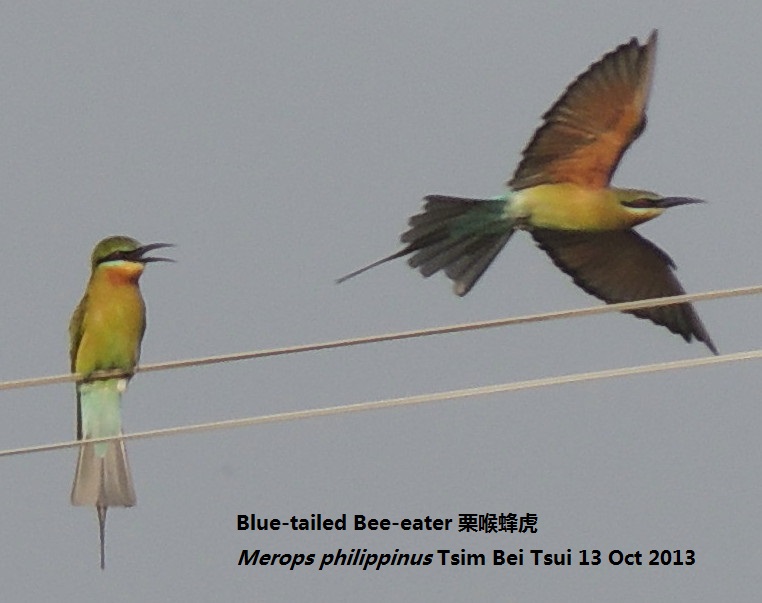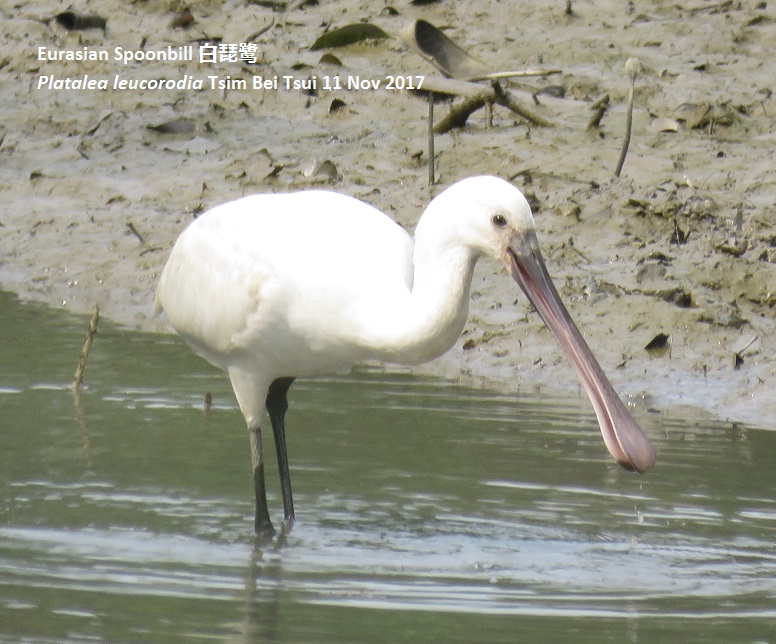Introduction
 Birding alongside ‘The Fence’ is a classic Hong Kong birdwatching activity and the area of fish ponds behind the barrier built to keep out illegal immigrants is diverse and interesting at most times of the year. However in the last few years few birders go there regularly. It can be good for stints in spring, if there is a suitable drained pond, and the fish ponds attract many migrants. The bay can be viewed from a parking area next to the Police Post at the beginning of the Fence. Tsim Bei Tsui is also the only site in Hong Kong where Collared Dove is regularly recorded (since 2002).
Birding alongside ‘The Fence’ is a classic Hong Kong birdwatching activity and the area of fish ponds behind the barrier built to keep out illegal immigrants is diverse and interesting at most times of the year. However in the last few years few birders go there regularly. It can be good for stints in spring, if there is a suitable drained pond, and the fish ponds attract many migrants. The bay can be viewed from a parking area next to the Police Post at the beginning of the Fence. Tsim Bei Tsui is also the only site in Hong Kong where Collared Dove is regularly recorded (since 2002).Two other sites worth checking in this area are Nam Sang Wai and the Hong Kong Wetland Park. The former is known as a place where it is possible to get good close-up views of gulls when the tide is right in winter. The latter opened to the public only in 2006 but should have the potential for some good birds.
Key Species
Temminck’s Stint, Long-toed Stint, Red-necked Stint, Collared Dove, Collared Crow.
Other Species
 Little Grebe, Great Crested Grebe, Great Cormorant, Grey Heron, Great Egret, Intermediate Egret, Little Egret, Chinese Pond Heron, Black-crowned Night Heron, Common Teal, Garganey, Northern Shoveler, Mallard, Spot-billed Duck, Osprey, Black Kite, Imperial Eagle, Greater Spotted Eagle, Common Buzzard, Common Kestrel, Peregrine, White-breasted Waterhen, Common Moorhen, Black-winged Stilt, Oriental Pratincole, Green Sandpiper, Wood Sandpiper, Common Sandpiper, Little Ringed Plover, Common Snipe, Red Turtle Dove, Common Koel, Greater Coucal, Lesser Coucal, Indian Cuckoo, Plaintive Cuckoo, Large Hawk Cuckoo, Asian Barred Owlet, Common Kingfisher, Black-capped Kingfisher, White-breasted Kingfisher, Pied Kingfisher, Fork-tailed Swift, House Swift, Asian House Martin, Barn Swallow, Red-rumped Swallow, Yellow Wagtail, Grey Wagtail, White Wagtail, Richard’s Pipit, Olive-backed Pipit, Red-throated Pipit, Long-tailed Shrike, Siberian Rubythroat, Bluethroat, Common Stonechat, Black-collared Starling, White-cheeked Starling, Red-billed Starling, White-shouldered Starling.
Little Grebe, Great Crested Grebe, Great Cormorant, Grey Heron, Great Egret, Intermediate Egret, Little Egret, Chinese Pond Heron, Black-crowned Night Heron, Common Teal, Garganey, Northern Shoveler, Mallard, Spot-billed Duck, Osprey, Black Kite, Imperial Eagle, Greater Spotted Eagle, Common Buzzard, Common Kestrel, Peregrine, White-breasted Waterhen, Common Moorhen, Black-winged Stilt, Oriental Pratincole, Green Sandpiper, Wood Sandpiper, Common Sandpiper, Little Ringed Plover, Common Snipe, Red Turtle Dove, Common Koel, Greater Coucal, Lesser Coucal, Indian Cuckoo, Plaintive Cuckoo, Large Hawk Cuckoo, Asian Barred Owlet, Common Kingfisher, Black-capped Kingfisher, White-breasted Kingfisher, Pied Kingfisher, Fork-tailed Swift, House Swift, Asian House Martin, Barn Swallow, Red-rumped Swallow, Yellow Wagtail, Grey Wagtail, White Wagtail, Richard’s Pipit, Olive-backed Pipit, Red-throated Pipit, Long-tailed Shrike, Siberian Rubythroat, Bluethroat, Common Stonechat, Black-collared Starling, White-cheeked Starling, Red-billed Starling, White-shouldered Starling.
Other Wildlife
Mongoose is not uncommon in this area.
Birding
Survey the Deep Bay waters for Great Crested Grebe and views of Dalmatian Pelicans across the other side of the bay. Osprey commonly perch on posts in the bay. Check out the disused paddies for Red Turtle Dove, Sooty-headed Bulbul, starlings, buntings and thrushes. Many species of wader occur in the ponds and this is also an excellent location for raptors. Collared Dove is relatively easy to find in the fish pond area and given the apparent spread of this species at other sites along the south China coast it is not unlikely that the species is naturally expanding its range southwards.

Habitat and Vegetation
Coastal mangrove, fishponds, disused paddy.
Getting there
Access to Tsim Bei Tsui is via Yuen Long or Tin Shui Wai. The easiest way to get to Yuen Long from Central is to take the MTR to Nam Cheong and change to the KCR West Rail which then goes on to Yuen Long. A green minibus #35 runs to Tsim Bei Tsui from Tai Fung street in Yuen Long. In order to avoid a long walk back continue through the fish ponds and out to the other side at Shing Uk Tsuen where green minibus #74 departs back to Yuen Long.To get to Tin Shui Wai there are direct Citibuses from Admiralty on Hong Kong island. From Yuen Long/Tin Shui Wai to Tsim Bei Tsui a taxi costs around HK$90. The Hong Kong Wetland Park, which opened in May 2006, is on the north side of Tin Shui Wai. To get there take West Rail to Tin Shui Wai and then take the LRT, route 705, 706 or 761, to Wetland Park station. From there it is a 5 minute walk to the Wetland Park itself. The entrance fee is HK$30 for adults.
Nam Sang Wai is located north-west of Kam Tin (and is shown on that map as well). There is no public transport to this site which is thus best reached by taxi either from Kam Tin or Yuen Long.
General Information
Altitude: 0-100m Disturbance: not significant. The bridge from Nim Wan to Shekou on the Shenzhen side of Deep Bay was completed in 2007 and has had an impact on the Deep Bay tides.